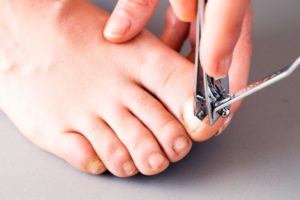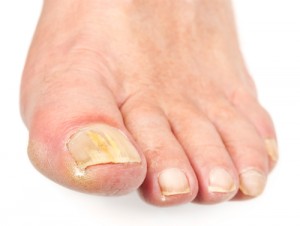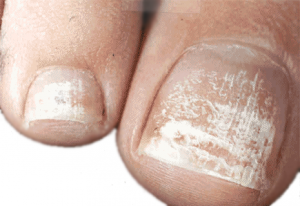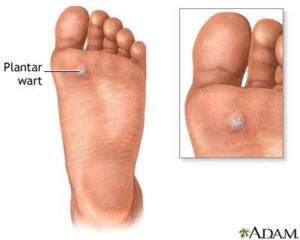Ingrown toenails can be massively frustrating – and not to mention very painful! They stop you from wearing shoes, partaking in sports and activities you enjoy and every step is a constant uncomfortable reminder that they’re still there!
So what does an ingrown toenail mean?
An ingrown toenail means that the nail edge has grown and curved into the adjacent skin. In most cases, the nail curves down into the skin, but in some cases it could be that there is excess skin/tissue surrounding the nail that the nail has grown into. It’s painful, uncomfortable and very frustrating if the pain doesn’t resolve – which it may not if any of the nail edge is still left hiding down in the skin!
 What causes ingrown toenails?
What causes ingrown toenails?
Many factors can encourage ingrown toenails but there is one biggie -an improper nail cutting technique. Toenails should ideally be cut in a straight, clean line with no fraying edges and no curves. Curving the edges of the nail can encourage the nail to grow curved down into the skin. Another is pulling at frayed nail edges and ‘picking’ your nails. This can leave a nail spicule at the edge of the nail which may then grow down into the skin. Because it can be residual nail spicules when they’re obstructed by the surrounding skin, you won’t evenrealise that it’s still in there. Tight footwear creates pressure on the sides of the toes that can push the nail into the surrounding skin. Sometimes the cause can be an uncontrollable genetic factor that dictates the way the nail is grown. Don’t worry – regardless of the cause there are definitely solutions to both alleviate ingrown toenails and to stop them from coming back once and for all!
What are the symptoms?
The biggest symptom is pain on touch, pressure and movement. The toe may often appear red and swollen. If you see a white/yellow exudate from the surrounding skin then it’s likely that you have picked up an infection. Because infections can occur anywhere that there is a skin break, it’s important to take extra care with ingrown toenails.
What can I do for it? Can I stop it from coming back permanently?
Those with diabetes, nerve damage or poor circulation should never attempt to treat their ingrown toenails at home. If you have good general health and suspect you have an ingrown toenail, soak the nail in warm salty water for 5 minutes then dry thoroughly. If pain persists, it will need to be examined by your Podiatrist that will determine the proper course of treatment.
Here at Perform Podiatry, we treat and manage ingrown toenails every day! We’ll start by examining the toe and the intruding nail, checking for infection and will then safely and cleanly clear the offending nail edge. This can be done with or without anaesthetic and we also offer
permanent solutions to permanently remove a small section of the nail to give you a clear, pain-free nail edge and stop the troublesome edge from growing back!
Stop putting up with that pesky toenail and give us a call to chat more about ingrown toenails and how we can help you too! Experience our commitment to excellence in Podiatry for yourself and get back to wearing the shoes you love!
 It’s been a fantastic, hot summer here in New Zealand, with lots of time wearing sandals, at the beach and feeling that soft, green grass beneath of our feet. For many of our patients recently, it’s also been the time that they’ve noticed a few unusual changes in the appearance of their toenails – usually yellow and white patches – and have come in to find out what it is and what they can do about it!
For many of these patients, the verdict is the same…
It’s been a fantastic, hot summer here in New Zealand, with lots of time wearing sandals, at the beach and feeling that soft, green grass beneath of our feet. For many of our patients recently, it’s also been the time that they’ve noticed a few unusual changes in the appearance of their toenails – usually yellow and white patches – and have come in to find out what it is and what they can do about it!
For many of these patients, the verdict is the same…
 Poor circulation
Poor circulation



 What causes ingrown toenails?
Many factors can encourage ingrown toenails but there is one biggie -an improper nail cutting technique. Toenails should ideally be cut in a straight, clean line with no fraying edges and no curves. Curving the edges of the nail can encourage the nail to grow curved down into the skin. Another is pulling at frayed nail edges and ‘picking’ your nails. This can leave a nail spicule at the edge of the nail which may then grow down into the skin. Because it can be residual nail spicules when they’re obstructed by the surrounding skin, you won’t evenrealise that it’s still in there. Tight footwear creates pressure on the sides of the toes that can push the nail into the surrounding skin. Sometimes the cause can be an uncontrollable genetic factor that dictates the way the nail is grown. Don’t worry – regardless of the cause there are definitely solutions to both alleviate ingrown toenails and to stop them from coming back once and for all!
What are the symptoms?
The biggest symptom is pain on touch, pressure and movement. The toe may often appear red and swollen. If you see a white/yellow exudate from the surrounding skin then it’s likely that you have picked up an infection. Because infections can occur anywhere that there is a skin break, it’s important to take extra care with ingrown toenails.
What can I do for it? Can I stop it from coming back permanently?
Those with diabetes, nerve damage or poor circulation should never attempt to treat their ingrown toenails at home. If you have good general health and suspect you have an ingrown toenail, soak the nail in warm salty water for 5 minutes then dry thoroughly. If pain persists, it will need to be examined by your Podiatrist that will determine the proper course of treatment.
Here at Perform Podiatry, we treat and manage ingrown toenails every day! We’ll start by examining the toe and the intruding nail, checking for infection and will then safely and cleanly clear the offending nail edge. This can be done with or without anaesthetic and we also offer
What causes ingrown toenails?
Many factors can encourage ingrown toenails but there is one biggie -an improper nail cutting technique. Toenails should ideally be cut in a straight, clean line with no fraying edges and no curves. Curving the edges of the nail can encourage the nail to grow curved down into the skin. Another is pulling at frayed nail edges and ‘picking’ your nails. This can leave a nail spicule at the edge of the nail which may then grow down into the skin. Because it can be residual nail spicules when they’re obstructed by the surrounding skin, you won’t evenrealise that it’s still in there. Tight footwear creates pressure on the sides of the toes that can push the nail into the surrounding skin. Sometimes the cause can be an uncontrollable genetic factor that dictates the way the nail is grown. Don’t worry – regardless of the cause there are definitely solutions to both alleviate ingrown toenails and to stop them from coming back once and for all!
What are the symptoms?
The biggest symptom is pain on touch, pressure and movement. The toe may often appear red and swollen. If you see a white/yellow exudate from the surrounding skin then it’s likely that you have picked up an infection. Because infections can occur anywhere that there is a skin break, it’s important to take extra care with ingrown toenails.
What can I do for it? Can I stop it from coming back permanently?
Those with diabetes, nerve damage or poor circulation should never attempt to treat their ingrown toenails at home. If you have good general health and suspect you have an ingrown toenail, soak the nail in warm salty water for 5 minutes then dry thoroughly. If pain persists, it will need to be examined by your Podiatrist that will determine the proper course of treatment.
Here at Perform Podiatry, we treat and manage ingrown toenails every day! We’ll start by examining the toe and the intruding nail, checking for infection and will then safely and cleanly clear the offending nail edge. This can be done with or without anaesthetic and we also offer